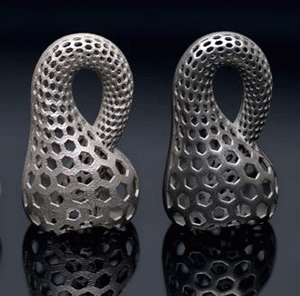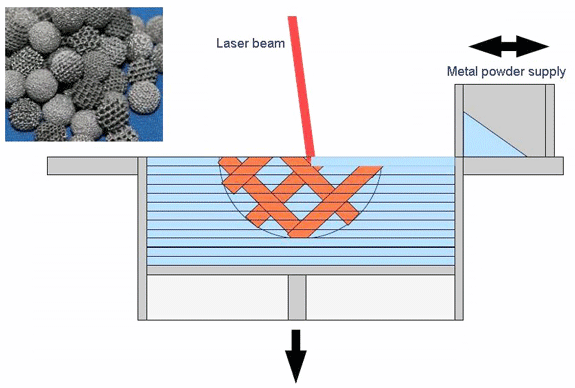PM-13 India: Special Session focuses on Additive Manufacturing
March 27, 2013
This special session began with a presentation from Prof K P Karunakaran, Mechanical Engineering Department, IIT Bombay, who traced the beginnings of Additive Manufacturing (AM) back to 1987, when 3D Systems launched Stereo-Lithography Apparatus (SLA) and demonstrated a new way of manufacturing through addition. New processes known as Rapid Prototyping (RP) or 3D Printing or, more appropriately, Layered Manufacturing (LM) came into vogue.
The production of effective tools via this process resulted in a drastic reduction in ‘time-to-market’. The capabilities of RP expanded in terms of materials, quality and process capabilities, from initially only making polymer components to now being capable of producing ceramic and metallic parts.
Several post-build processes have emerged today to improve the surface quality (e.g. liquid polishing) and material integrity (for example, Hot Isostatic Pressing (HIP)). RP& AM, in conjunction with these post-build processes, allows rapid development of even very complex products such as those used in an aero engine.
Prof Karunakaran identified some of the unique capabilities of RP & AM as allowing:
- Components/tools with conformal cooling channels,
- Objects with gradient materials,
- Components of non-equilibrium materials,
- Assemblies without joints (elimination of welded joints),
- Difficult/impossible shapes by other means
- Customised solutions for aesthetic, ergonomic and bio-medical applications.
It was suggested that the term “3D printing” refers to economical AM processes, in the range of USD $5,000-25,000, which can be part of any design office just as with 2D printers. This equipment is only suited to the quick physical realisation of a design for visualisation and review. Rapid Prototyping (RP) is a more advanced form of this process, which caters to mostly polymer components, but with assured quality and wide variety of materials so that they can be used for more complex applications of form, fit and functional tests. Rapid Manufacture (RM) is seen as the highest level which includes metals and ceramics and goes beyond prototyping. RM, through its many facets of direct and indirect routes (Vacuum Casting, Epoxy Tooling, Rapid Casting etc.), can be useful in regular production as well. While 3D printing and RP have linearity of cost with quantity, RM has the distinction of cost reducing with quantity.
Deepak Grover and Hans Söderhjelm, Höganäs Digital Metal, described Additive Manufacturing as a process of building components in layers directly from 3D CAD data, without the need for complex and expensive tools and with minimal waste material. Unlike Rapid Prototyping, Additive Manufacturing goes to the next level by being able to mass produce end user products.
Höganäs Digital Metal, stated Grover, offers a revolutionary and innovative manufacturing technique for metallic components. It is a proprietary precision ink-jet technology for Additive Manufacturing and 3D printing of metal components and systems. This offers a unique capacity to rapidly and cost effectively produce highly complex and intricate designs and features for metallic parts.
Dr Mukesh Agarwal, 3D Product Development (3DPD), Bangalore, felt that today’s product development requirements have become more demanding, with the gap between product design cycle and mass manufacturing often required to be bridged by low volume production quantities. The product life cycles became shorter and, in many cases, products are being designed for limited volume.
This demand for low volume production has resulted in conventional Rapid Prototyping processes being adapted and adopted as “Additive Manufacturing” for low volume production. According to Dr Agarwal, given material limitations with traditional Rapid Prototyping processes, these processes are sometimes not even suitable to produce fully functional prototypes.
Powders and feedstock
Dr Rama Mohan R Tallapragada, Consultant, Mumbai, India, discussed the importance of powders and feedstock for successful Additive Manufacturing. During his presentation he referred to his paper presented during PM-02, the 2nd International conference on Powder Metallurgy in Automotive Applications held at New Delhi in 2002. That paper dealt with the then emerging techniques of Rapid Prototyping and their usefulness. A decade later his presentation discussed the rapid changes in the technologies such as production of prototypes, visual design aids, touch, feel, fit and assembly test parts, etc., that are used in the product development phase. For the real production parts at all levels the technology had evolved into Rapid Manufacturing techniques. These generally refer to techniques, he stated, that produce shaped parts by gradual creation or addition of material, as distinguished from forming and manufacturing through material removal.
The need for production of complex components with little or no machining by Powder Metallurgy (PM) techniques has seen injection moulding become a popular processing technique. The tools and dies required for injection moulding are themselves complex and in order to process these, the technology of Rapid Prototyping or Solid Free-form Fabrication (SFF) etc. has been utilised.
A Computer Aided Design (CAD) model of the required free-form is created and converted into STL format (after the process Stereo Lithography, for which 3D systems developed this format). The latter is sliced into thin cross-sectional layers and the output is fed to the Rapid Prototyping machine which then builds the free-form, one layer at a time. The free-form is then sintered to yield the final product.
Many layered manufacturing techniques are in vogue, with the most popular being: photo-polymerization (Stereo lithography (SLA) and its derivates), ink-jet printing (IJP), 3D printing (3DP), Fused Deposition Modeling (FDM), Selective Laser Sintering or Melting (SLS/ SLM and EBM1) and to a lesser extent Laminated Object Manufacturing (LOM and similar sheet stacking processes) and laser cladding (LC) processes. Many of the techniques are, however, limited to Rapid Prototyping as they do not allow common engineering materials to be processed with sufficient mechanical properties.

Fig. 5 FDM extrudes thermoplastic materials in filament form to produce parts layer by layer (Courtesy Stratasys)
The RM techniques are extensively used in processing ceramics and ceramic-polymer composites. The most popular techniques for metal powders are FDM and SLS. The latter often uses metal powders along with polymers. Complex shapes such as gears, turbine blades, etc. are produced.
Powders for laser sintering are generally spherical, fine and gas atomised. Where non spherical powders are to be used these should be coated with a polymeric binder and mixed to form loose agglomerates and then coated with lubricant/ plasticiser to minimise frictional forces and cause easy sliding.
In conventional sintering the particles are not fundamentally changed unlike in laser sintering, where the particles are fully or partially melted. Necessary feedstock properties include being free flowing with a size that must allow a reasonable finish. The binder must melt and “backbone” the powder to deliver required properties. Powder flow is affected by particle shape and size distribution, but the finer the powder the less it flows – the best combination is <50m and rounded.
The technology, however, is in the early stages as far as Powder Metallurgy applications are concerned. Developing a proper powder mix is a considerable challenge to the powder producers as it involves new generation inks, gels, pastes and powder blends etc. Some of the feed stock can be in the form of metal powder-polymer blends, wires, rods, granules etc.
Useful links
To submit news and articles for publication on Metal Additive Manufacturing email us at [email protected]
Metal-AM homepage | Latest News | Articles | Subscribe to our free e-newsletter





















